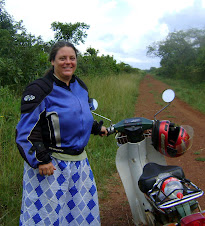 Here's a photo from a nutrition class which was held at my house a few days ago. In the background you can see my wood fired oven and the support poles for the roof. In the foreground there are Ugandan men and women who were representatives from three different churches who came to learn. In addition to some basic nutrition teaching, I include practical applications. From prior teachings and some seed assistance, a number of people in these churches have started home vegetable gardens. With this group, I have previously done teaching which included how to make a carrot cake. Carrot cake is an incentive to plant carrots which are high in vitamin A, a common deficiency in Africa. Ugandans are typically crazy about cakes-- something they know as they get one bite servings at weddings. (The cake is cut into small pieces and passed around.) This group wanted to know how to use the vegetables they are growing including carrots and zucchini, plus they wanted more on cakes. So, this teaching featured a vegetable bean soup with zucchini, carrots, green peppers, onion, tomatoes etc. We also did a high protein "cake" I created which is basically a modified cornbread-- it contains soy, 2 eggs and a cup of milk per cake with only 4 spoonfuls of sugar per cake. I added spices (cinnamon and what they call here "mixed spice") to cover the flavor of the soy. It makes a mildly sweet slightly spiced cake which takes advantage of the natural sweetness of maize. We had three teams doing the cooking, and a great time was had by all. Don't be fooled by the photo--Ugandans' typically put on a serious face for photos, kind of like some of the early days of photography in the US.
Here's a photo from a nutrition class which was held at my house a few days ago. In the background you can see my wood fired oven and the support poles for the roof. In the foreground there are Ugandan men and women who were representatives from three different churches who came to learn. In addition to some basic nutrition teaching, I include practical applications. From prior teachings and some seed assistance, a number of people in these churches have started home vegetable gardens. With this group, I have previously done teaching which included how to make a carrot cake. Carrot cake is an incentive to plant carrots which are high in vitamin A, a common deficiency in Africa. Ugandans are typically crazy about cakes-- something they know as they get one bite servings at weddings. (The cake is cut into small pieces and passed around.) This group wanted to know how to use the vegetables they are growing including carrots and zucchini, plus they wanted more on cakes. So, this teaching featured a vegetable bean soup with zucchini, carrots, green peppers, onion, tomatoes etc. We also did a high protein "cake" I created which is basically a modified cornbread-- it contains soy, 2 eggs and a cup of milk per cake with only 4 spoonfuls of sugar per cake. I added spices (cinnamon and what they call here "mixed spice") to cover the flavor of the soy. It makes a mildly sweet slightly spiced cake which takes advantage of the natural sweetness of maize. We had three teams doing the cooking, and a great time was had by all. Don't be fooled by the photo--Ugandans' typically put on a serious face for photos, kind of like some of the early days of photography in the US.We cooked the cakes in my WFO since I could cook all the cakes at once while they watched. The cake's rising in the oven took those who hadn't attended the prior class by surprise. Here most people have never seen a cake baking. The wood fired oven worked great and the cakes came out perfectly. Many people were intrigued by the oven too. It is built out of mud and brick so I wouldn't be surpised if people start building there own. I made it by combining an old roman design with the mexican horno oven. Here most people cook over a three stone open fire, but I wanted my baked goods:) For those who don't have an oven, I also explained how to use local pans as a Dutch oven and how to build a simple oven out of the heavy aluminum pans found here. I'm also reseaching low-firewood ovens, and may modify my oven to include a low firewood option based on the rocket stove (lots of videos of Utube if you don't know what a rocket stove is.) The one drawback to the oven is that it uses a lot of firewood. Cooks great though!
The groups organizer, a lay reader named Apollo, also came back today and we arranged for a low-cost mosquito net sale and scheduled a nutrition teaching at a church 3 miles from here on Satuday. P.S. Those who pray, you could pray for my safety traveling to that church. I'll be riding my 90 cc motorcycle out there. The road we take is a road I hate where it is in poor condition but large trucks still zoom by you--sometimes inches away and kicking up a cloud of dust that blinds you. Oh, and while 3 miles doesn't sound that far, distances are often vastly underestimated. The last "5 mile" trip I took was around 30 kilometers and over an hour by pickup truck.





















